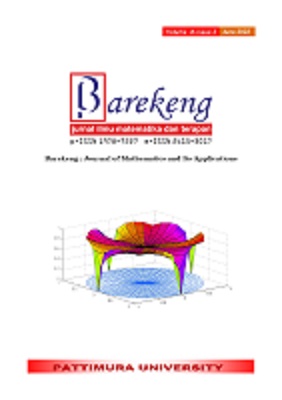RESTRICTED MAXIMUM LIKELIHOOD ESTIMATION FOR MULTIVARIATE LINEAR MIXED MODEL IN ANALYZING PISA DATA FOR INDONESIAN STUDENTS
Abstract
The Program for International Student Assessment (PISA), becomes one of the references or indicators used to assess the development of students' knowledge and skills in each member country of the Organization for Economic Cooperation and Development (OECD). The results of the PISA survey in 2018 placed Indonesia in the bottom 10, indicating that the implementation of the national education system has not been successful. This underlies the need for a more in-depth study of the factors that influence PISA data scores not only statistically qualitatively but also quantitatively which is still very rarely done. The data structure of the PISA survey results is complex, which involves multicollinearity, multivariate response variables, and random effects. Thus, it requires an appropriate statistical analysis method such as the multivariate mixed linear regression (MLMM) model. In this study, secondary data from the results of the 2018 PISA survey with Indonesian students as the smallest unit of observation were used as sample. School is used as an intercept random effect which is assumed to be normally distributed. Multicollinearity is overcome by selecting independent variables based on AIC and BIC values. Estimation of variance and random effect parameters was performed using the restricted maximum likelihood (REML) method. Based on the estimator of the variance of random effects for the response variables of mathematics, science, and reading literacy, it was obtained 1548.12, 1359.39, and 1082.48, respectively, which explains the significant effect of each school as a random effect on the three response variables.
Downloads
References
P. McCullagh and J. A. Nelder, “Generalized Linear Models, Second Edition.” p. 532, 1989.
T. J. Hastie and D. Pregibon, “Generalized linear models,” Statistical Models in S. pp. 195–247, 2017, doi: 10.1201/9780203738535.
M. A. Jaffa, M. Gebregziabher, L. M. Luttrell, and A. A. Jaffa, “Multivariate Generalized Linear Mixed Models With Random Intercept To Analyze Cardivascular Risk Markers In Type-1 Diabetic Patient,” vol. 43(8), p. p.1447-1464, 2016, doi: 10.1186/s12967-015-0557-2.
M. Gebregziabher, Y. Zhao, C. . Dismuke, N. Axon, J. K. Hunt, and L. E. Egede, “Joint modeling of multiple longitudinal cost outcomes using multivariate generalized linear mixed models,” 2018.
G. Oskrochi, E. Lesaffre, Y. Oskrochi, and D. Shamley, “An application of the multivariate linear mixed model to the analysis of shoulder complexity in breast cancer patients,” International Journal of Environmental Research and Public Health, vol. 13, no. 3, 2016, doi: 10.3390/ijerph13030274.
I. Pratiwi, “Efek Program Pisa Terhadap Kurikulum Di Indonesia,” vol. Vol. 4(1), p. 51, 2019.
OECD, “PISA 2018 Assessment and Analytical Framework,” 2019.
R. Pakpahan, “Faktor - Faktor Yang Memengaruhi Capaian Literasi Matematika Siswa Indonesia Dalam PISA 2012 Factors Affecting Literacy Mathematics Achievement Of Indonesian Student In PISA 2012,” vol. 1, 2016.
V. M. Santi, K. A. Notodiputro, and B. Sartono, “Variable selection methods applied to the mathematics scores of Indonesian students based on convex penalized likelihood,” J. Phys. Conf. Ser., vol. 1402, no. 7, 2019, doi: 10.1088/1742-6596/1402/7/077096.
V. M. Santi, K. A. Notodiputro, and B. Sartono, “Generalized Linear Mixed Models by Penalized Lasso in Modelling The Score of Indonesian Students,” Journal of physics: Conference Series AASEC, August 8, 2021.
S. Breakspear, “How does PISA shape education policy making? Why how we measure learning determines what counts in education,” Cent. Strateg. Educ. Semin. Ser., no. 240, p. 16, 2014.
A. G. Bluman, Elementary Statistics: A Step by Step Approach, Eighth Edi. New York, 2012.
D. M. Berridge and R. Crouchley, Multivariate generalized linear models using R, vol. 39, no. 8. Taylor & Francis Grup, 2011.
I. N. Latra, S. Linuwih, Purhadi, and Suhartono, “Estimation for Multivariate Linear Models,” Linear Model Theory, vol. 10, no. 06, pp. 243–262, 2010, doi: 10.1002/9780470052143.ch12.
C. E. McCulloch and S. R. Searle, Generalized, Linear and, Mixed Models. New York: John Wiley and Sons, Inc., 2001.
J. Jiang and T. Nguyen, Linear and Generalized Linear Mixed Models and Their Applications, vol. 50, no. 1. Springer, 2021.
OECD, “Sampling in PISA,” no. March 2016, pp. 1–14, 2016.
Authors who publish with this Journal agree to the following terms:
- Author retain copyright and grant the journal right of first publication with the work simultaneously licensed under a creative commons attribution license that allow others to share the work within an acknowledgement of the work’s authorship and initial publication of this journal.
- Authors are able to enter into separate, additional contractual arrangement for the non-exclusive distribution of the journal’s published version of the work (e.g. acknowledgement of its initial publication in this journal).
- Authors are permitted and encouraged to post their work online (e.g. in institutional repositories or on their websites) prior to and during the submission process, as it can lead to productive exchanges, as well as earlier and greater citation of published works.






1.gif)



